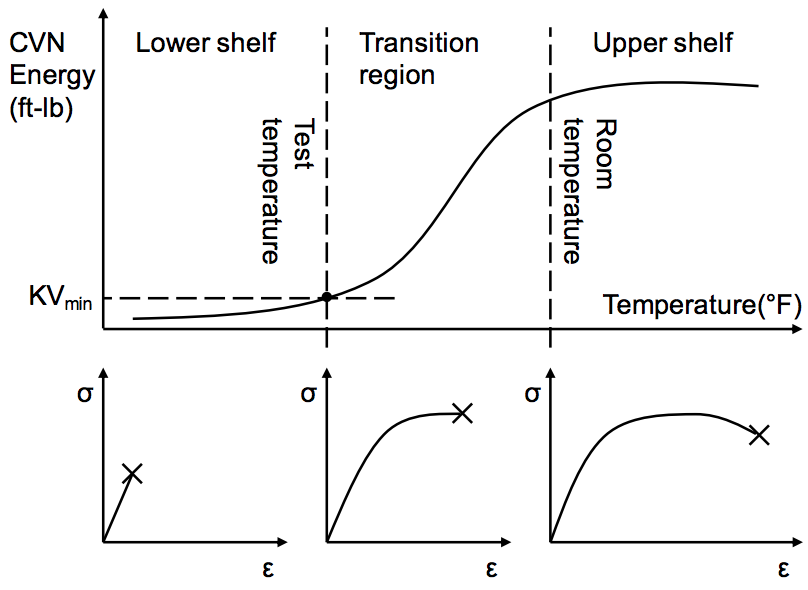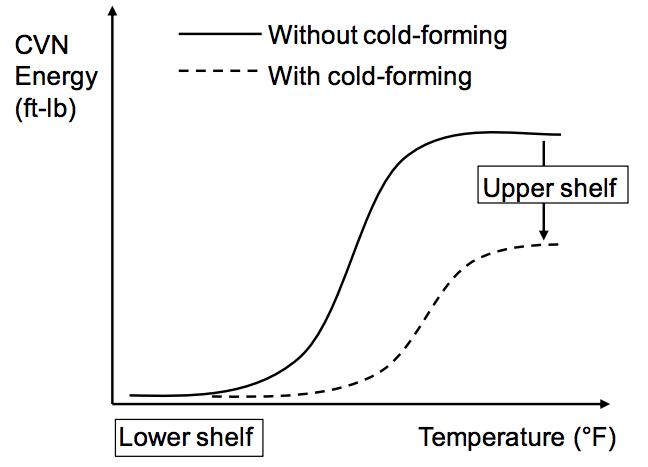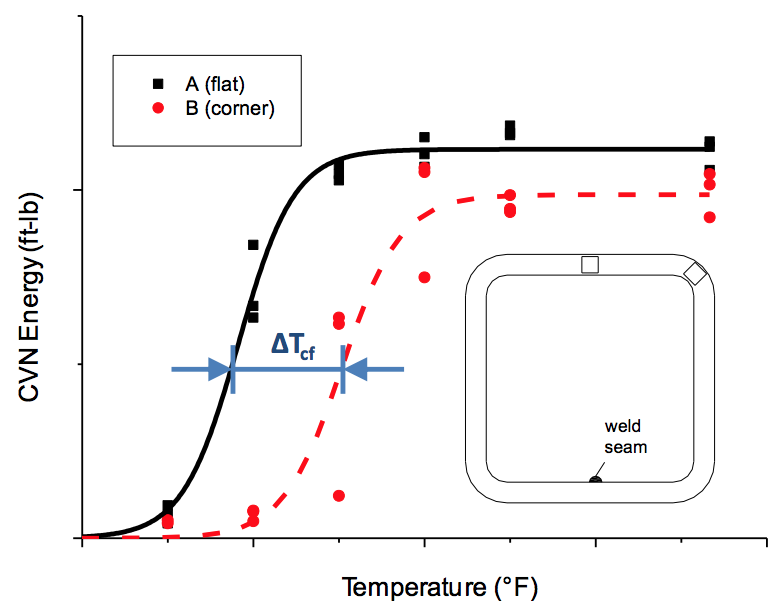Charpy V-Notch Toughness Of HSS
By Jeffrey A. Packer
Bahen/Tanenbaum Professor of Civil Engineering, University of Toronto, Ontario, Canada
The selection of steel for notch toughness is critical for low-temperature service or dynamic loading applications, due to the possibility of brittle fracture of a component. For the assessment of material toughness, international standards commonly require Charpy V-notch (CVN) impact testing of the steel product. A required toughness level is commonly expressed for a particular test temperature (which may be different to the lowest anticipated service temperature) at which a minimum CVN impact energy value (KVmin), shall be achieved. The approximate relationship between the CVN energy-temperature curve and the fracture behavior of a steel component is illustrated in Figure 1.

The toughness of cold-formed HSS depends not only on the toughness of the coil material used to manufacture the HSS, but also on the degree of cold-forming introduced to the cross-section during production. As illustrated in Figure 2, cold-forming lowers the material toughness. In general, the cross-sectional geometry of the HSS product is a good indicator of the degree of cold- forming contained in the section. For Circular Hollow Sections (CHS), the toughness level around the cross-section is consistent since the coil material is cold-bent to the same curvature at all locations. On the other hand, for Rectangular Hollow Sections (RHS), the toughness at the corner region can be significantly lower than that of the flat face due to uneven degrees of cold-forming, depending on whether the RHS was manufactured using the “direct-forming” or “continuous-forming” method. A comparison between material properties of direct-formed and continuous-formed RHS can be found in Sun and Packer (2014a and 2014b).

The prime American standard for cold-formed HSS, ASTM A500 (2013a), has no notch toughness requirement. Thus, it is necessary to specify CVN testing of the A500 HSS product before using it for low-temperature service or dynamic loading applications.
To offer cold-formed HSS suitable for dynamically loaded structures, ASTM A1085-13 (2013b) was developed recently. This specifies that, for HSS product manufactured to this standard, its toughness shall be accessed by testing CVN specimens taken in the longitudinal direction (away from the seam weld) of the tube. The average CVN impact values of the test specimens shall conform to the minimum requirement of 25 ft-lb at 40 °F, based on full-sized (10×10 mm with a 2 mm deep notch) test specimens. Such a CVN toughness level (at the test location) is adequate for dynamic loading application for the “Zone 2” service temperature range (0 °F to -30 °F) as per the AASHTO bridge design specification (2007). However, it should be noted that, for RHS, ASTM A1085-13 (2013b) specifies that the CVN specimens be taken from the flat face of the tube. Unlike CHS, the toughness level around the cross-section of RHS is inconsistent due to non-uniform amounts of cold-forming. Thus, the CVN impact values of test specimens taken from the flat face do not necessarily represent the toughness property of the entire cross-section of the RHS.
Extensive investigations have been conducted on the effect of cold-forming on the toughness of European HSS, which formed the current rules for the selection of European HSS for overall notch toughness (Feldmann et al., 2012). A survey of these investigations can be found in Sun and Packer (2014b). However, since these tests were carried out mainly with HSS made of EN 10219 S355J2H steel, the rules in (Feldmann et al., 2012) refer to this material type only (i.e. are not necessarily applicable to HSS produced in North America).
Similar investigations on North American HSS were limited until recently. Based on extensive CVN testing on HSS with different cross-sectional geometries and produced by different methods at the University of Toronto (Kosteski et al., 2005; Sun and Packer, 2014b), it has been concluded that:

(1) When selecting RHS for notch toughness, serious consideration should be given to the CVN toughness deterioration from flat face to corner (i.e. the weak spot) such that the entire cross-section is “fit for purpose”. This can be done by either specifying the corner as an alternate measuring location, or considering the deterioration from the flat face to the corner if the CVN toughness was measured in the standard location (flat face). Experimental results (see Figure 3) showed that there are generally large temperature shifts (ΔTcf) between the CVN energy-temperature curves of the flat face and the corner of the RHS tested. Such temperature shifts can be up to 72 °F, depending on the cross-sectional geometry and the cold-forming method of the RHS. Thus, to be conservative, a 72 °F temperature shift can be implemented by a designer when specifying the flat face CVN toughness if a certain toughness level is required to be met in the corner. For example, a specification of 25 ft-lb at -32 °F in the flat face of a RHS would ensure a CVN rating of 25 ft-lb at 40 °F in the corner region, as per ASTM A1085-13.
(2) For CHS, since the toughness level is consistent around the cross-section, the method in ASTM A1085-13 can be applied directly.
(3) For HSS with wall thickness less than 11 mm, ASTM A370 (2009) specifies the use of sub-sized CVN specimens. Due to the fact that the width of the sub-sized specimen is reduced, it has to be notched on the narrow side (i.e. the specimen has a notch through the HSS wall thickness) in order to have enough cross-sectional area for impact testing (ASTM 2009). On the other hand, for thick-walled HSS where full-sized CVN specimens are possible, ASTM A370 permits the notch to be either on the HSS surface or through the HSS wall thickness. However, according to experimental evidence (Sun and Packer 2014b), the latter notch orientation generally produces a lower CVN toughness reading. Hence, it is recommended that, for thick-walled HSS, full-sized CVN specimens should be machined with a through-thickness notch to produce conservative test results.
References
AASHTO. 2007. “AASHTO LRFD Bridge Design Specifications”, 4th. edition. American Association of State Highway and Transportation Officials, Washington, DC.
ASTM. 2009. “Standard Test Methods and Definitions for Mechanical Testing of Steel Products”, ASTM A370-09a. American Society for Testing and Materials, West Conshohocken, PA.
ASTM. 2013a. “Standard Specification for Cold-Formed Welded and Seamless Carbon Steel Structural Tubing in Rounds and Shapes”, ASTM A500/A500M-13. American Society for Testing and Materials, West Conshohocken, PA.
ASTM. 2013b. “Standard Specification for Cold-formed Welded Carbon Steel Hollow Structural Sections (HSS)”, ASTM A1085-13. American Society for Testing and Materials, West Conshohocken, PA.
Feldmann, M., Eichler, B., Kühn, B., Stranghöner, N., Dahl, W., Langenberg, P., Kouhi, J., Pope, R., Sedlacek, G., Ritakallio, P., Iglesias, G., Puthli, R.S., Packer, J.A. and Krampen, J. 2012. “Choice of Steel Material to avoid Brittle Fracture for Hollow Section Structures”. JRC Scientific and Policy Report No. 72702, European Commission Joint Research Centre, Luxembourg.
Kosteski, N., Packer, J.A. and Puthli, R.S. 2005. “Notch Toughness of Internationally Produced Hollow Structural Sections”, Journal of Structural Engineering, American Society of Civil Engineers, Vol. 131, No. 2, pp. 279-286.
Sedlacek, G., Feldmann, M., Kühn, B., Tschickardt, D., Höhler, S., Müller, C., Hensen, W., Stranghöner, N., Dahl, W., Langenberg, P., Münstermann, S., Brozetti, J., Raoul, J., Pope, R. and Bijlaard, F. 2008. “Commentary and Worked Examples to EN 1993-1-10 ‘Material Toughness and Through Thickness Properties’ and other Toughness Oriented Rules in EN 1993”. JRC Scientific and Policy Report No. 47278, European Commission Joint Research Centre, Luxembourg.
Sun, M. and Packer, J.A. 2014a. “Direct-Formed and Continuous-Formed Rectangular Hollow Sections – Comparison of Static Properties”. Journal of Constructional Steel Research, Vol. 92, pp. 67-78.
Sun, M. and Packer, J.A. 2014b. “Charpy V-Notch Impact Toughness of Cold-Formed Rectangular Hollow Sections”. Journal of Constructional Steel Research, Vol. 97, pp. 114-126.
October 2014